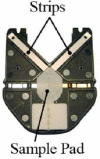Advances in hemoglobin A1c point of care technology
- PMID: 19885097
- PMCID: PMC2769587
- DOI: 10.1177/193229680700100314
Advances in hemoglobin A1c point of care technology
Abstract
Measurement of hemoglobin A1c (A1C) has long been accepted as the best indicator of glucose control over time. Assays for A1C use technologies based on either charge differences (high-pressure liquid chromatography) or structure (boronate affinity or immunoassay combined with general chemistry). These technologies are generally employed in expensive laboratory instruments. More recently, A1C technology has been incorporated into point of care (POC) devices, allowing for immediate availability of A1C measurements, greatly facilitating diabetes care in both specialist and general practices. POC A1C tests should have acceptable performance, standardization to national reference, National Glycohemoglobin Standardization Program (NGSP) certification, simple operation without need for costly instrumentation, and Clinical Laboratory Improvement Amendments (CLIA) waiver. CLIA-waived POC technology includes Bio-Rad MicroMat II (distributed by Cholestech as GDX) and the Axis-Shield Afinion, both of which utilize boronate affinity. The DCA 2000(R)+ utilizes combined immunoassay and general chemistry. These instruments cost $1000 to $3000 and require regular maintenance, making them appropriate only for high-volume physician offices. The newly improved A1CNow+ also utilizes combined immunoassay and general chemistry, but the small, inexpensive, disposable monitor can be used by patients as well as by health care professionals. The new version of A1CNow+ has improved performance through recent introduction of automated solid state chemistry manufacturing, improved fluidics and automated assembly of the test cartridge, error-correcting software, and unitary meter calibration with factory calibration directly to the NGSP reference standard.
Keywords: A1C; CLIA waived; glycated hemoglobin; hemoglobin A1c; point of care.
Figures






References
-
- Burtis CA, Ashwood ER, editors. Tietz textbook of clinical chemistry. 3rd. Philadelphia (PA): WB Saunders; 1999.
-
- CDC National Diabetes Fact Sheet, United States, 2005.
-
- Hogan P, Dall T, Nikolov P. American Diabetes Association. Economic costs of diabetes in the US in 2002. Diabetes Care. 2003;26(3):917–932. - PubMed
-
- Phillips LS, Ziemer DC, Doyle JP, Barnes CS, Kolm P, Branch WT, Caudle JM, Cook CB, Dunbar VG, El-Kebbi IM, Gallina DL, Hayes RP, Miller CD, Rhee MK, Thompson DM, Watkins C. An endocrinologist-supported intervention aimed at providers improves diabetes management in a primary care site: improving primary care of African Americans with diabetes (IPCAAD) 7. Diabetes Care. 2005 Oct;28(10):2352–2360. - PubMed
-
- Standards of Medical Care in Diabetes 2007. American Diabetes Association. Diabetes Care. 2007;30:S4–41. - PubMed
LinkOut - more resources
Full Text Sources
Other Literature Sources

